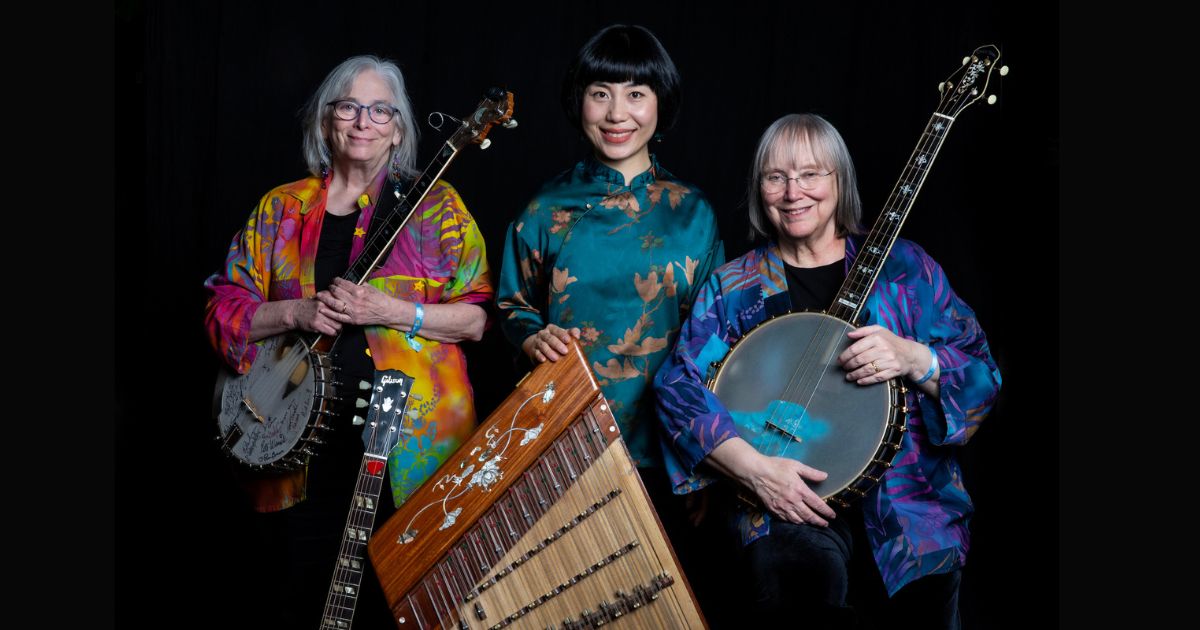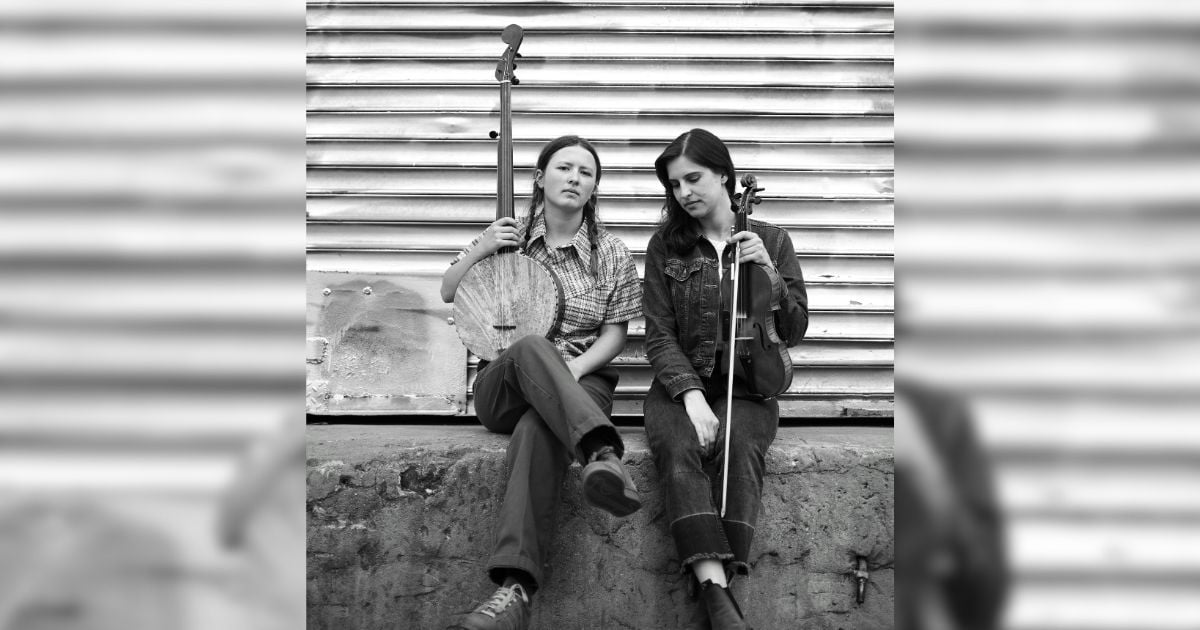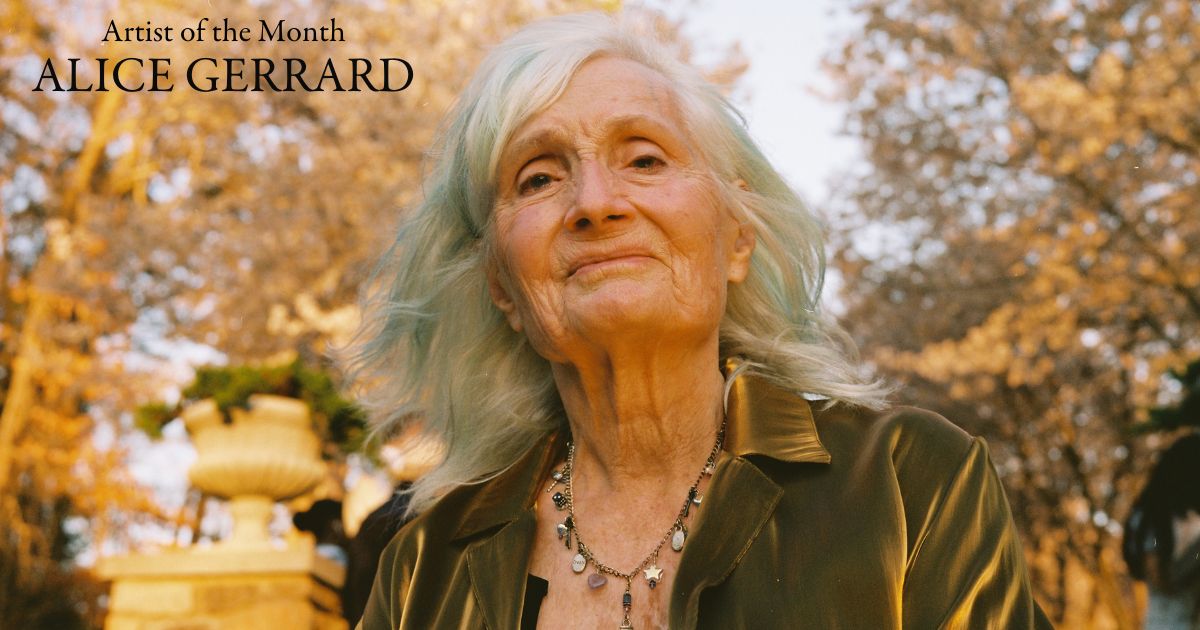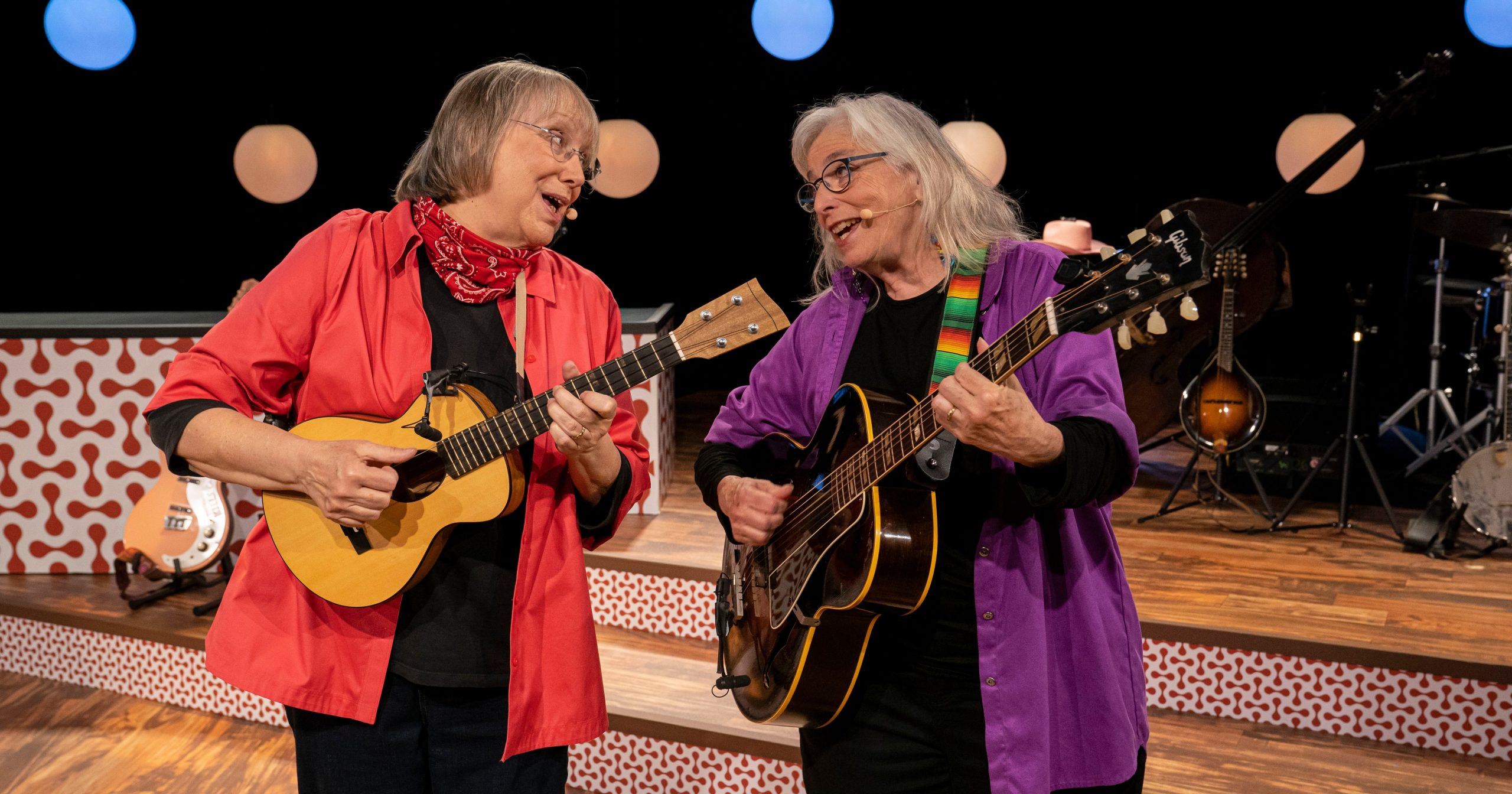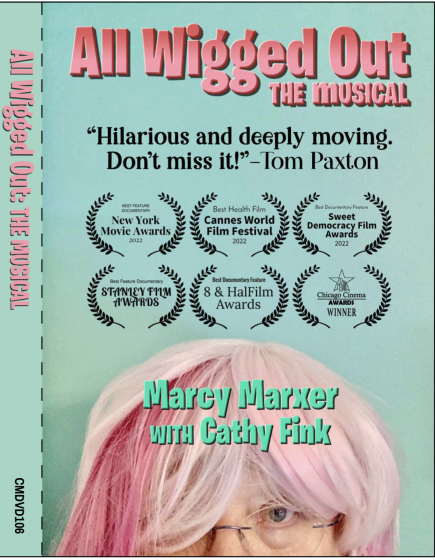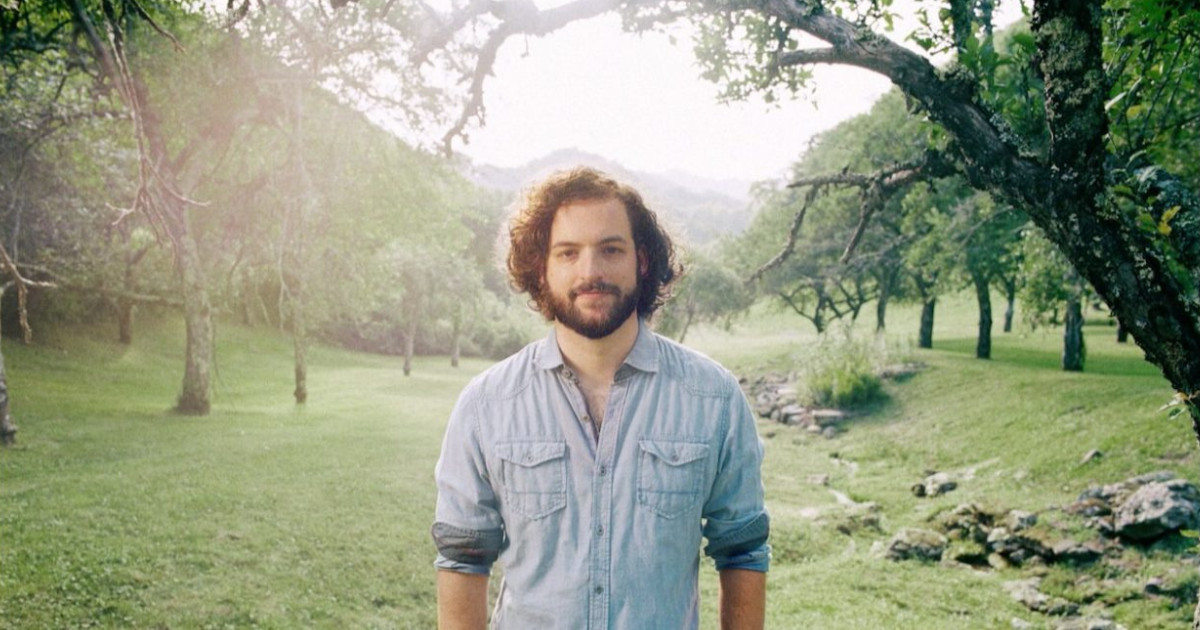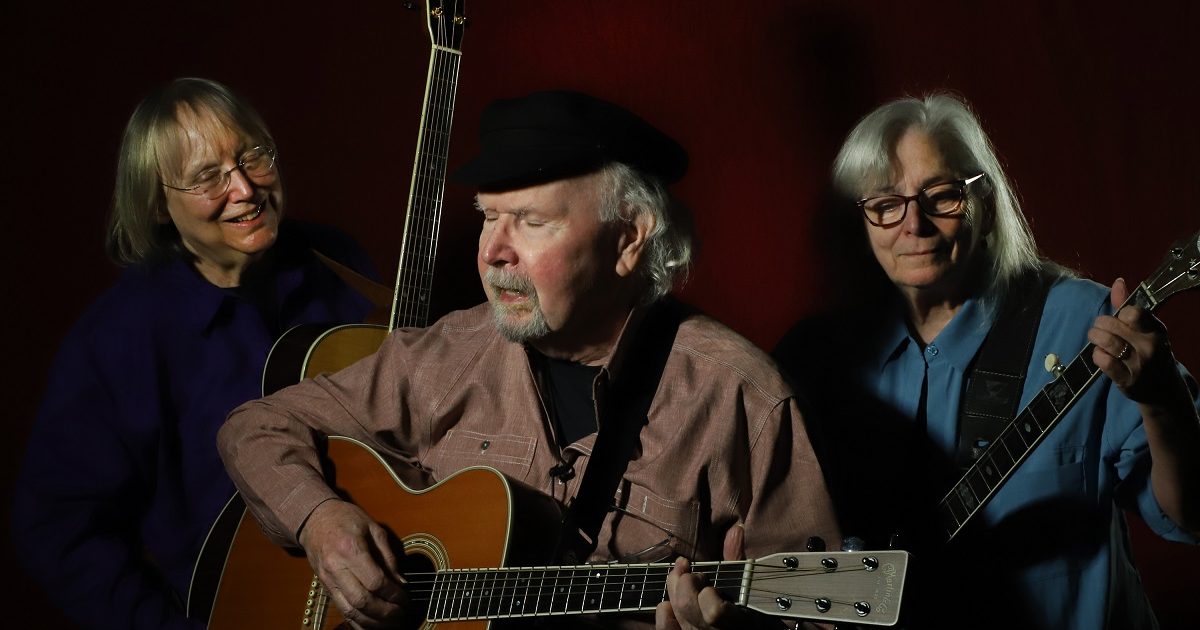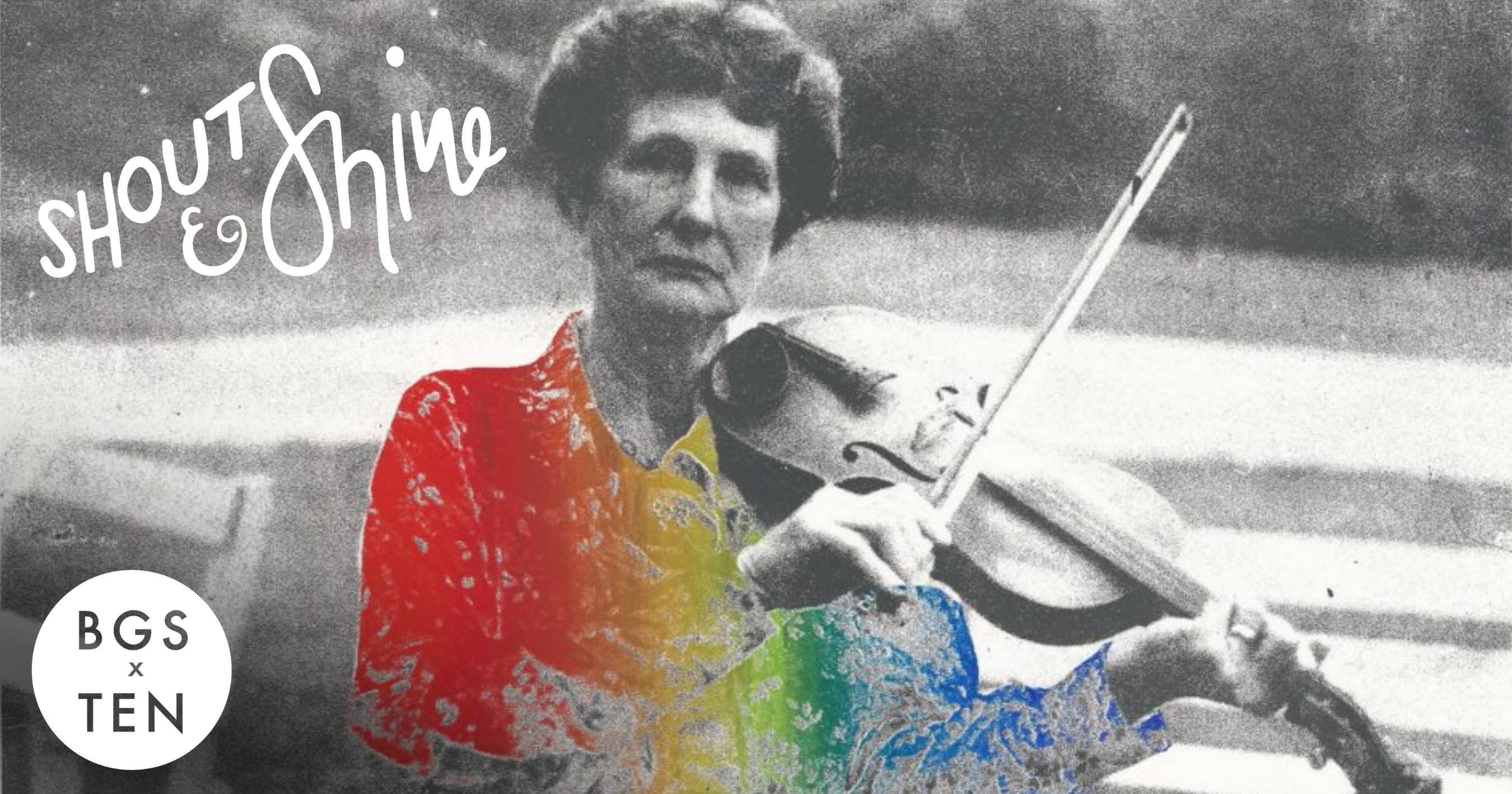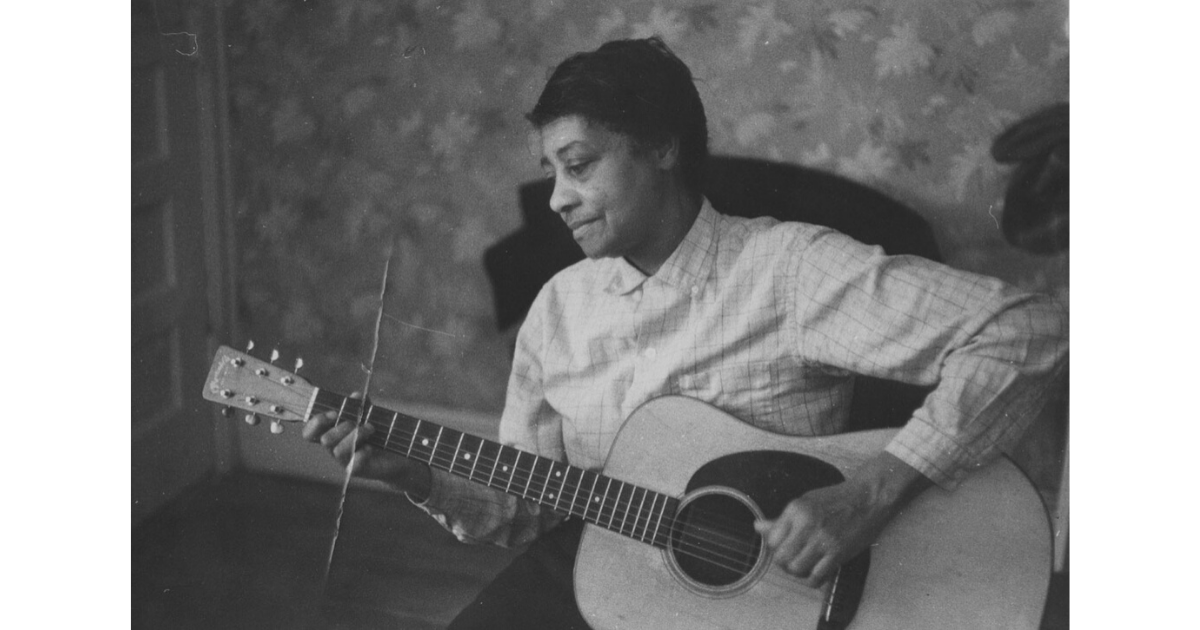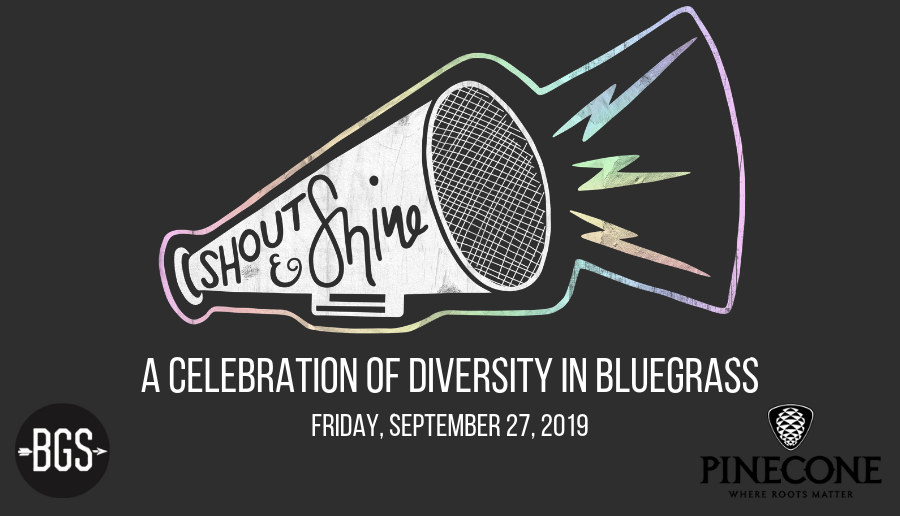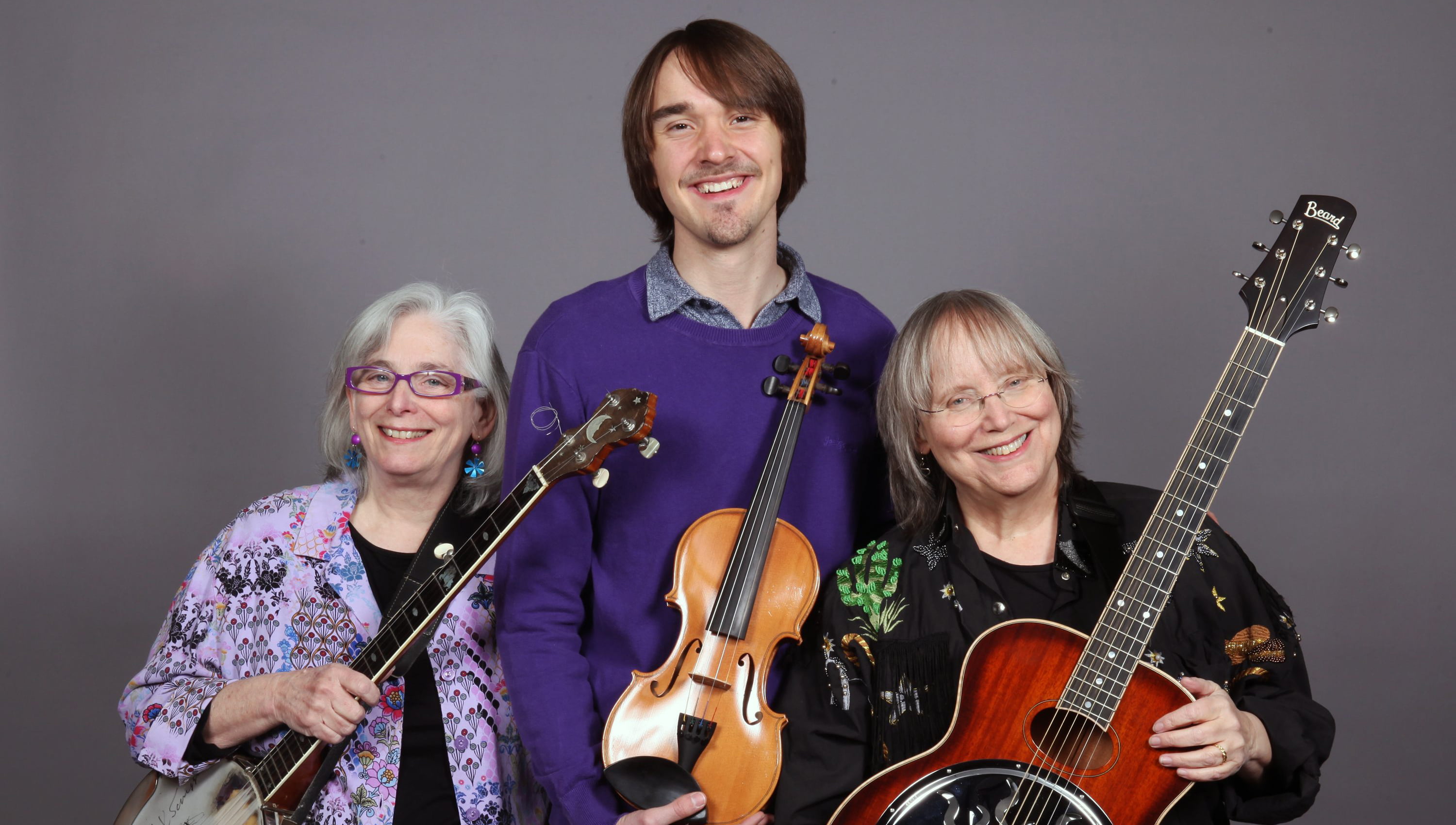“What do Chinese and Appalachian music have in common?” is not really the central question in the minds of Cathy Fink, Marcy Marxer, and Chao Tian, whose From China to Appalachia concerts may first appear wildly random in their combination of instruments and styles. To these expert folk musicians, the real question is, “What don’t Chinese and Appalachian music have in common?” The latter would have a much shorter answer.
There’s a sense of belonging, of homeyness, of ease to this musical collaboration. With their primary configuration including Chinese hammered dulcimer played by Tian, clawhammer five-string banjo played by Fink, and cello banjo played by Marxer, those overarching moods could feel surprising, but for this trio there is really no such thing as not belonging.
Fink and Marxer have constructed every facet of their lifelong careers with community building centered – that’s how they connected with Tian, after all, when she participated in a fellowship program at Strathmore Arts Center nearby their home in Maryland. Fink & Marxer host their hugely popular UkeFest at Strathmore, and Fink is often a mentor of fellowship artists such as Tian. When the three began making music together, they realized the seamlessness of their musical and cultural vocabularies almost immediately.
@cathybanjo @chaotianmusic #yangqin #fromchinatoappalachia #banjo #clawhammerbanjo #culturaldiplomacy #grammywinners @freshgrassfoundation #hammereddulcimer #cellobanjo #trio #concert ♬ original sound – Cathy Fink
That realization, it turns out, is contagious. Recently, a simple promotional video of the trio performing a song to highlight a slate of performances went viral on TikTok. At the time of this writing, it has gained more than 550,000 views, more than 101,000 likes, and 14,000 saves. (Theirs is a music well worth holding onto for later.) Fink, Marxer, and Tian immediately noticed an impact from the viral video at their shows, with multiple dates selling out and new fans driving hundreds of miles to catch a tour date.
Listening to the three perform, the ease and charm of the music – however disparate its parts may feel – is immediately apparent, whether through a screen, a workshop, a community event, a concert, or a sing along. It’s clear that Cathy, Marcy, and Chao are using their music to teach the world and anyone who will listen that with roots music, there’s no such thing as not belonging.
We spoke to Fink, Marxer, and Tian via FaceTime last month, as they prepared for a short tour in the mid-Atlantic and immediately following their viral TikTok. The trio will continue touring From China to Appalachia throughout 2024 with appearances planned at Wintergrass, in the Northeast with special guest Jake Blount, and beyond.
Let’s start with your recent viral video on TikTok, I wonder what you might think is so exciting about this particular combination of instruments? Because, clearly there is something about this lineup that has resonated with folks! I have a couple of my own ideas about it, but I wonder what you think is particularly electric about banjos and Chinese dulcimer together?
Cathy Fink: Chao, do you want to start?
Chao Tian: Okay! So, I play the Chinese dulcimer, right? The most common question that people ask me in this country is, “What’s the difference between the Chinese one and the American hammered dulcimer?” They share a similar history. The Chinese dulcimer was actually introduced to China by British travelers back more than 500 years ago. And, somehow I have just felt, when I play with Appalachian musicians, or play American Roots music, I feel like I’m home. This instrument actually feels the same way – back home. It just melts into this genre of music smoothly and without any problems. The music languages are quite matchable, perfectly.
I feel like if I try to collaborate with musicians of any other type of genre – like, I play with jazz musicians – I need to learn their language. For Appalachian music, I just feel like I speak it, not the native language, but some kind of accent. But, without any limitations to communicate with those musicians.
I wanted to ask you, also, because one of the first things that came to mind for me when I saw your collaboration is Abigail Washburn collaborating with Wu Fei. Could you talk a little bit about the difference between a guzheng and a dulcimer and about your approaches and how they differ?
CT: Yes, that’s another question that people think about when they see our collaboration. Some of them just bluntly ask us, “What’s the difference?” Instrumentally we have some differences [from Wu and Washburn], because Cathy and Marcy, they are multi-instrumentalists. They can play more [instruments] and our music style is versatile.
The dulcimer’s history and background is quite different from the guzheng, because guzheng is a Chinese instrument traditionally and dulcimer is actually a worldwide instrument. As I said, [the U.S.] is a home country of this instrument.
We have a collaborative vibe and more like a family vibe. Like a family reunion… I define our collaboration as an intercultural collaboration. For most people’s opinions, they see us, too, like an intercultural thing. But when people talk about intercultural collaboration, we somehow initially think about what’s the difference between these two cultures, or three cultures, or among different cultures.
Our collaboration is based on mutual understanding and cultural respect. When we started this collaboration, we noticed there are a lot of commonalities between Chinese traditional music and American roots music. So this intercultural collaboration transformed from, “Let’s just try something” into, “Let’s delve into more about the musical language, the musical form, the scales–”
Because there are similar scales we use – the pentatonic scale, the modes. The format of the folk musics are similar, very similar. I always feel like even though folk music, those little tunes are short, but they can contain very powerful, immense messages that we can deliver to people.
And I really think our title, From China to Appalachia, actually is a very clear description. Yes, literally, but it’s not only that. Some people on TikTok suggested a very interesting idea, that we should replace China with my hometown, Beijing, because Appalachia is a region and China is a country, right? But actually we use that title not to describe the geographic thing, we are talking about music. We’re talking about culture. So from China to Appalachia, there is something that strongly linkages between them. Not only musically, not only culture, but also on a people to people level.
We should try our best to find what our commonalities are, more than trying to show, “I am special! I am special! You should listen to me! You should listen to me more!” So, it’s just musical healing.
That’s such a great answer and it makes me think of, Cathy and Marcy, how you’ve always placed community so central in how you make music. It’s not something that’s an after effect of music making for you. It’s something that’s very present in the beginning stages when you make music. Can you talk about how this project is another example of how you build community with all the music making that you do?
CF: It’s definitely that and I thank you for recognizing that. Right now, we’re in the midst of a tour that is co-sponsored by Mid Atlantic Tours of Mid Atlantic Arts. To our delight, one of the criteria for presenters participating [in the program] is that there be a community outreach event. In each place that we go, that event is different. We’ve performed for some high school kids, and this weekend our outreach was playing music at a Unitarian service. I have to tell you, it was the most beautiful service of community gathering and worship without using two words that you almost always hear in a church – God and Christ. Everyone was included. They didn’t care who you worshiped. They didn’t care who you were. If you wanted to come together and be in community, then please come in the door. For us to play music in that scenario was really amazing.
In Fredonia, [New York], it just so happened that Emily Schaad – a fiddler in the old-time music community, but also a phenomenal conductor and classical musician – had just moved to Fredonia, and we were playing at the Fredonia Opera House. They reached out to Emily and said, “How about putting together a workshop?” So, Emily had her orchestra students come and she reached out to all of the regional youth bluegrass organizations. We had a room of like 75 people – her orchestra students, kids learning bluegrass, Appalachian dulcimer players, tuba players, horn players, you name it. There was an amazing cello player who took over on Marcy’s cello banjo and immediately understood what it was.
We put together an arrangement of a tune and that was meaningful to everybody. Then, we have something coming up this weekend in Martinsville, Virginia at a place called Piedmont Arts and we’re so excited about it. Our first set is going to be based on our repertoire, we’re just going to pick what we want for an hour long set. In our second set, there’s a Chinese watercolor artist, local to that community, who has an exhibit at Piedmont Arts right now, and he’s going to be on stage creating a new watercolor while we play music, much of it improvised.
I think this grant [from Mid Atlantic Arts] has opened the door to more community. I think it will be a centerpiece of every place we go. When this grant is finished and presenters are interested in us, one of the things that we’re going to say is, “What collaborative community thing can we do?” How can we meet more people eye-to-eye, music-to-music, or whatever it may be?
Community is one of the most important things that this show and our collaboration stands for, and we’ve made music with Chao for, I don’t know, six years or so. She did some touring with us and Sam Gleaves, which was really fun. We did a little run out to Ashe County Arts Council there, in our neighborhood. And that was an interesting test for how does this music fly in Appalachia? It was just amazing, the response.
When we started doing more work together, remember that when COVID hit, there was a lot of anti-Asian sentiment in the country. We felt like making this music together was our statement of community and of humanity. We never had to say a thing about it. We just had to all be there together and present a very honest sense of community and love.
It’s perhaps another reason why this TikTok video of yours took off. Because, I think a lot of people, whether consciously or subconsciously, when they see banjos they might not know anything about banjo music besides stereotypes. I think there’s something about this lineup, and in particular the mission that you’re bringing to the music, that makes it so inviting to folks. You’re not just saying, “Come and listen to us.” You’re saying, “Come be a part of this.”
I think that’s part of why people see and hear this music and it might come off as intellectual or cerebral music, but they’re responding to it in a very down to earth way and they feel invited by it.
CF: And it’s very participatory. I will tell you, in Richmond, when we started singing and playing “High on a Mountain,” there were a lot of people there who knew the song. We just said, “Sing it with us!” And my God, did they ever sing it with us. There are several songs in the show full of sing-along participation, and I’m going to guess that a lot of the new fans through TikTok and social media haven’t been to a lot of folk concerts where that’s kind of an expected part of what happens.
But we have a very full circle story with a piece that Chao brought to the group after she heard a recording of Pete Seeger and Arlo Guthrie doing it. It’s a Chinese song called, “Three Rules of Attention and Eight Points of Discipline.” They recorded it in 1975. It’s a really awkward choice in many ways, because it deals specifically with peasants who were leaving Chiang Kai-shek’s army for the Red Army. They used this particular piece of music in the Red Army to teach what I’m going to call, “rules of humanity.” When you hear and read these rules of humanity, and you look at what’s going on in the world today, you go, “Oh my God, 1928, this song?” And Chinese people in the audience feel like we’ve brought them back to their home and their childhood.
It’s a really interesting thing. Pete has, of course, a thousand people whistling on it with him. I can’t whistle worth nothing. Marcy’s pretty good at whistling. but we get the audience singing “La” and taking over the song and we’re all there together
I wanna make a quick point about Abigail and Wu Fei, because so many people make that immediate connection, too. First of all, I wanna say that we’re friends with Abigail and Chao has met Wu Fei, and I find that what we do is, separately, is very complementary. There are some differences – you know, Abby speaks fluent Chinese! Chao’s trying to teach us to sing in Chinese, and we’re working on it every day. That’s a little part of how she’s stretching us in some ways. And then we’re stretching her in some ways.
Additionally, in our show From China to Appalachia, there’s a sort of hidden parentheses: “And beyond.” From China to Appalachia (and Beyond). It’s a big focus of ours to collaborate on Chinese and Appalachian music, but it is also a real joy to pick a Django Reinhardt piece like “Dark Eyes,” which Marcy plays on the mighty ukulele. So then we have ukulele and guitar and Chinese dulcimer. Or, we’ve kind of reinvented Cousin Emmy’s “Ruby.” We have a gourd banjo, Marcy on the doumbek – she’s got a pink Barbie doumbek – and Chao on hammered dulcimer. Chao does things on hammered dulcimer that no one else does. She’s got a slide she uses on it, she’s got all these interesting sounds.
We certainly see what we do as embracing a lot of different world music concepts and basically, we feel like it’s all very complimentary. We’d love nothing better than to share a show and collaborate with Abby and Wu Fei.
That’s perfect as a segue, because I also wanted to talk about sonics and about the music itself. Marcy, I wonder if you could talk a little bit about how as you’re crafting these tunes, how are you thinking about building the ensemble? How do you decide which instruments you’re going to utilize when?
Marcy Marxer: At first, we just try a bit of everything and see what works best. For me personally, the cello banjo is working really well in this group. My main instrument is guitar, of course, and I will be playing more guitar in the future, but I love the high angelic overtones of the hammer dulcimer with Cathy’s banjo ringing and then the cello kind of being, as Chao calls it, the panda of the group. [Laughs] The giant panda. [That combination] is just a sonic sound that I’ve never heard before.
You know, the hammered dulcimer was so popular in the ‘70s and ‘80s in old-time, traditional music. Then it kind of fell out of favor. Much of that had to do with the fact that the hammered dulcimer was hard to tune and the rest of the group would have to tune to the dulcimer. But it’s such an engaging sound. I mean, it really captured my heart ever since I was a little tiny child, listening to my grandma play, and then playing it myself. I think it’s really time for the hammered dulcimer to come back. I mean, we still have a generation or two of hammered dulcimer players who are 60 and over and some younger players, but I’m not so aware of them. But, I’d love to see the hammered dulcimer really come back into American traditional music in a way that younger people can still learn from the masters.
Audiences have always loved the hammered dulcimer. It’s just like old-time festivals and jams where it kind of fell out of favor to a point that some hammered dulcimer players just don’t go.
We need to bring that back, because there’s just a spirit and a liveliness to the dulcimer that nothing else has. You’ve got your percussion, you’ve got your sparkling tones, you’ve got your deep tones. It’s a real joy to play along with, to hear Cathy’s banjo and Chao’s dulcimer together just blows me away sometimes. It’s really stunning. And then to be able to add the lower stuff and take some solos. For me, that’s the comedy part, the cello banjo solos always make people laugh.
CF: Marcy’s kind of like the pinch hitter, right? I do three things: I sing, I play whatever banjo is the best banjo for the moment, and I play rhythm guitar. Like Marcy, I think the unique center of our sound is the cello banjo, the five-string banjo, and the hammered dulcimer. But then Marcy adds ukulele. She adds a mandolin. She adds tin whistle if it’s appropriate. She has percussion things. She plays the doumbek. With each song that we play, Marcy and I are going in our heads, “What does she play that might add something to this, that we don’t mind schlepping on the road?” [Laughs]
Marcy describes this sometimes like you have this box of crayons. Chao’s got a big fat crayon, I have two or three small crayons, and Marcy owns the rest of the box! [Laughs]
Photo Credit: Jeff Fasano
